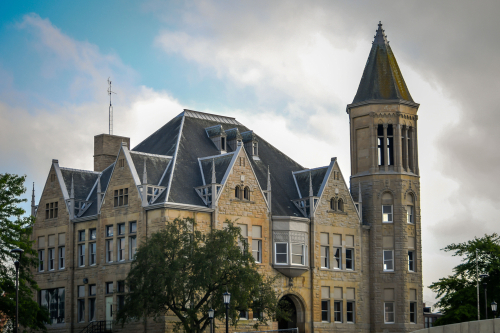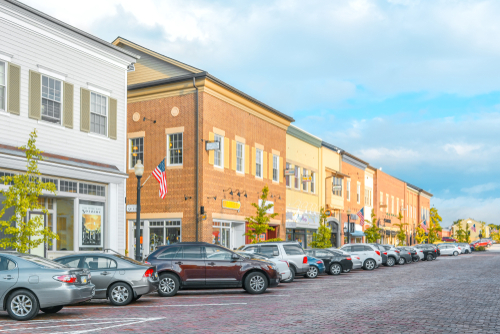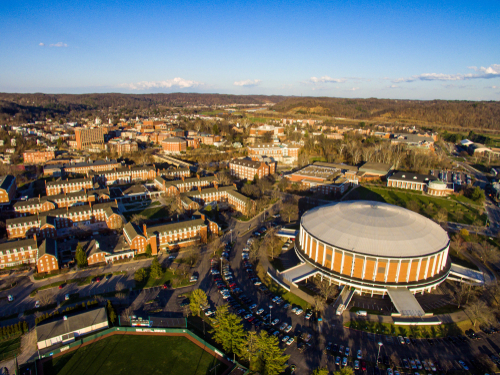
As if college weren’t expensive enough, living costs on top of tuition fees can be a nightmare to pay. Off-campus housing, food, and transportation can all be costly for those on the typical college budget. Fortunately, college towns vary dramatically.
Ohio’s cost of living is around 12% lower than the national average. Ohio is a much more affordable place to live than many of its neighbors in the Midwest. This is good news for students attending any of Ohio’s more than 130 colleges and universities.
Methodology for Ohio College Towns
Our editors used Wikipedia to make a list of every college town in Ohio, then used Sperling’s Best Places to rank them on general affordability. To figure out which college towns are most affordable, we looked at costs for:
- housing
- food
- health
- transportation
- utilities
We then compared them to the national average. We also considered features like:
- amenities
- crime rates
- public transportation
- overall quality of life
We then narrowed our list down to the 20 most affordable college towns in Ohio.
Ranking Your Top Ohio College Town Choices
Youngstown
Youngstown State University
Cost of Living: 29.4% Lower than the National Average; 17.1% Lower than the State Average
Youngstown has a:
- small-town feel
- unique history
- lush green spaces
- gorgeous collection of historic buildings
Youngstown was recently named the best college town in the Midwest by America Unraveled. Forbes even ranked Youngstown as the fourth best city in the U.S. to raise a family, citing the town’s low crime rate and great cost of living. An active local sporting scene offers plenty of opportunity for athletes and sports fans alike. It also has:
- a community theater
- full events calendar
- walkable downtown area
.All less than the national average are costs for:
- food
- healthcare
- transportation
- utilities
- entertainment
Housing costs of only 25% of the U.S. median make it easy for students to live well in off-campus homes and apartments.

Akron
University of Akron
Cost of Living: 26.6% Lower than the National Average; 14.3% Lower than the State Average
If there’s a rule that says cities aren’t college-budget friendly, then Akron is the exception. Akron’s surprisingly low housing costs are only 33% of the national average. This is definitely a rarity among other mid-size cities. Akron has lower rates for:
- healthcare
- food
- utilities
- transportation
- entertainment
With all the money Akron residents save on housing, they can afford to take advantage of the city’s many features and attractions. These include:
- museums
- a civic theater
- the F.A. Seiberling Nature Realm
- a zoo
- a concert venue, and much more.
Nelsonville
Hocking College
Cost of Living: 25.2% Lower than the National Average; 12.9% Lower than the State Average
With a full-time population of about 5,000, and a college of almost 6,000 students, Nelsonville is the very definition of an Ohio college town. Hocking College, known for its technical programs, is a mere three-minute drive from the picture-perfect downtown. Housing costs are about 60% less than the national average. Students in Nelsonville can live in a prime location without breaking the bank. The town’s calendar is chock-full of local events, and a healthy tourism scene contributes to the solid local economy.

Tiffin
Tiffin University, Heidelberg University
Cost of Living: 22.8% Lower than the National Average; 10.5% Lower than the State Average
Tiffin is home to two major universities: Tiffin University and Heidelberg University. With a cost of living that is lower than both the national and state averages, Tiffin is a great place for:
- students
- young professionals
- families
- retirees
A nature center, a theme park, and various museums are popular tourism destinations. It also has:
- public libraries
- parks
- a walkable downtown area
Tiffin provides residents with everything they need for a high quality of life. Utilities costs in Tiffin are right on par with the national average. Lower than the national norm are costs for:
- food
- healthcare
- transportation
- entertainment
- housing are lower.
Toledo
University of Toledo, Davis College, Mercy College of Ohio, Herzing University
Cost of Living: 22.4% Lower than the National Average; 10.2% Lower than the State Average
Home to a slew of colleges and universities, Toledo is one of the most affordable small cities in the United States. Accommodation costs are typically 64% cheaper than other cities Toledo’s size. This means students have any number of affordable housing options to choose from. Entertainment costs also average below the national norm. This is good news considering Toledo’s myriad entertainment offerings contribute much to its quality of life. And while Toledo consistently ranks among the best places to live and to raise a family, the city was interestingly came in eighth on a ranking of “America’s Manliest Cities.”

Ashland
Ashland University
Cost of Living: 19.7% Lower than the National Average; 7.4% Lower than the State Average
Who wouldn’t want to live in a place that has declared itself “The World Headquarters for Nice People?” Ashland is an inviting small town with a student population that adds a unique level of zest and energy. Cost of living here is lower than both the national and state averages. Students who want to live off campus can expect to pay somewhere around $550 for a one-bedroom apartment. Also below the national norm are costs for:
- food
- utilities
- healthcare
- transportation
- entertainment.
Wooster
College of Wooster
Cost of Living: 17.3% Lower than the National Average; 5% Lower than the State Average
College of Wooster students are likely to find the town of Wooster to be an upscale and sophisticated place. The walkable downtown area is a nice place to stroll. It’s lined with:
- locally owned shops
- boutiques
- cafes
Food costs here are about 7% less than the national average. This is good news considering Wooster’s top-notch restaurant scene. The Wooster-based Ohio Light Opera provides great entertainment, while Ohio’s Amish country starts just outside of town.

Oberlin
Oberlin College
Cost of Living: 16.7% Lower than the National Average; 4.4% Lower than the State Average
Oberlin has been a college town since way back in 1833. The town and college were founded together by a Presbyterian minister and a missionary. Today, the town of a Oberlin is an energetic, politically active place well known for its progressive student population. Food costs are about 7% lower than the national average. A wide variety of student budget-friendly restaurants and cafes exist downtown. Also below the national norm are costs for:
- healthcare
- utilities
- transportation
- entertainment
Students wanting to live off campus will be happy to know that Oberlin housing costs are only about 72% of the national average.
Findlay
University of Findlay
Cost of Living: 15.6% Lower than the National Average; 3.3% Lower than the State Average
It was called one of the “Top 100 Communities for Young People” — twice! — by America’s Promise Alliance. Findlay is a small Ohio town with:
- a well-respected university
- fun local atmosphere
- cost of living that should put a smile on anyone’s face
Housing costs are only about 74% of the national average. This means a student can get a one-bedroom apartment for around $564 per month. Also less than the norm are costs for:
- food
- transportation
- healthcare
Low healthcare costs are especially good news considering Blanchard Valley Hospital in Findlay is consistently ranked amongst the best hospitals in the nation.
Athens
Ohio University
Cost of Living: 13.1% Lower than the National Average; .8% Lower than the State Average
Athens is home to the oldest college in Ohio. It’s is an upscale community that manages to simultaneously be both laid-back and tons of fun. While there’s not much public transportation here, Athens’ cost of living is higher than the Ohio average, but below the national average. The historic downtown boasts popular restaurants and breweries, and a growing arts and music scene. Students who enjoy a good time will especially love Athens come Autumn, when the town throws a Halloween bash that attracts folks from miles around.
Kent
Kent State University
Cost of Living: 12.9% Lower than the National Average; .6% Lower than the State Average
Kent has changed dramatically in recent years, and has established itself as even more of an energetic and charming college town. More than $100 million in private and public investments have revitalized both the campus and downtown. The town hosts dozens of student-friendly:
- restaurants
- shops
- clubs
Though Kent’s cost of living is nearly 13% lower than the national average, this upscale-feeling community is right on par with the Ohio norm. Every major cost-of-living category falls under the national average. Best of all, housing is still only about 74% of the median U.S. cost.

Berea
Baldwin Wallace University
Cost of Living: 11.3% Lower than the National Average; 1% Higher than the State Average
Though it’s located only 15 miles from downtown Cleveland, Berea is a small, tight-knit community with a long history as a college town. Indeed, Baldwin Wallace University was founded in 1845, less than a decade after Berea itself. Today, the quaint downtown is still charming and historical. Locally owned shops and restaurants are interspersed with big city-type stores and amenities. Entertainment is the only cost-of-living category to rank higher than the national average. Housing costs come in at only 73% of the national norm.
Cincinnati
University of Cincinnati, Xavier University, Mount St. Joseph University
Cost of Living: 10.4% Lower than the National Average; 1.9% Lower than the State Average
Cincinnati has:
- a slew of colleges and universities
- a young and vibrant atmosphere
- an ideal Midwest location
- a cost of living that is less than most other cities its size
Cincinnati is a fantastic place to spend one’s college years. Housing costs are only about 70% of the national average. There are a great variety of apartment and homes to choose from in and around the city. Similarly, below the national norms are costs for:
- food (lots of great restaurants)
- healthcare (world-class hospitals)
- utilities
- entertainment (two professional sports franchises).

Bowling Green
Bowling Green State University
Cost of Living: 10% Lower than the National Average; 2.3% Higher than the State Average
Home to Bowling Green State University, the town of Bowling Green is both safe and affordable. Plus, its laid-back vibe makes it a great college town in which to live and work. The cost of living here, though slightly higher than most other towns in Ohio, is easy on a student wallet. Only entertainment costs average on par with the norm. All below the national average are costs for:
- food
- healthcare
- utilities
- transportation costs
Students looking to live off campus will be glad to know that Bowling Green has a variety of housing types available around the campus. Housing costs average only about 83% of the national average.
Columbus
The Ohio State University
Cost of Living: 9.6% Lower than the National Average; 2.7% Higher than the State Average
Though not a traditional college town, Columbus tends to be dominated by the 66,000 students who attend The Ohio State University. North of downtown, the city seems to cater to the city’s massive student population, including:
- shops
- restaurants
- cafes
- bars
Between the university and the city, there are plenty of budget-friendly options to fill one’s time. These include:
- Mirror Lake
- the art galleries at Wexner Center for the Arts
- beautiful Thompson Library, to name a few.
The cost of housing is roughly 75% of the national average. Also averaging less than the national norm are costs for:
- food
- healthcare
- entertainment.

Oxford
Miami University
Cost of Living: 8.3% Lower than the National Average; 4% Higher than the State Average
Home to Miami University, Ohio’s second oldest university, Oxford is the epitome of a charming college town. The university boasts
- 2,100 acres
- 188 buildings
- 19,500 students
It’s easily the town’s main employer. Because the local economy is so rooted in the university, students have plenty of budget-friendly options, including:
- housing
- food
- entertainment
Oxford’s downtown (called “uptown” here) is a charming place for a stroll. Hueston Woods State Park, located just north of town, is the perfect getaway spot for a day of:
- hiking
- boating
- golf.
Hiram
Hiram College
Cost of Living: 6.4% Lower than the National Average; 5.9% Higher than the State Average
Hiram is perhaps best known as a former home of President James Garfield. It’s also the home of Hiram College (where Garfield attended and even taught). The historic downtown makes for a nice student hangout. Restaurants like Gionino’s Pizzeria are particularly popular among Hiram students. For those who love the outdoors, Hiram is the official launching point for canoe tours of the Upper Cuyahoga River. An upscale community, Hiram’s overall cost of living is just a hair under the national average. Costs below the U.S. median include:
- food
- healthcare
- housing
- utilities
- transportation
- entertainment.

Gambier
Kenyon College
Cost of Living: 4.4% Lower than the National Average; 7.9% Higher than the State Average
Gambier is home to top-ranked Kenyon College. Gambier has a cost of living that’s above the Ohio average, but just slightly lower than the national norm. Part of the reason for Gambier’s higher cost of living is its beautiful rural setting. Situated among gently rolling hills and bordered by the Kokosing River, Gambier is:
- quaint
- charming
- tight-knit
The downtown has shops and restaurants to provide residents with the necessities. Those who occasionally need big city amenities will be happy to know that Columbus is less than an hour’s drive away. If you’re looking for charm among Ohio college towns, check out Gambier.
Yellow Springs
Antioch College
Cost of Living: 3.7% Higher than the National Average; 16% Higher than the State Average
For those who like their Ohio college towns to be artsy and quirky, Yellow Springs won’t disappoint. Home to Antioch College, this tight-knit little town is a fun and vibrant community full of:
- students
- artists
- entrepreneurs
- other creative types
The community calendar is chock-full of street fairs and other artistic events. The Glen Helen Nature Reserve and nearby John Bryan State Park are the perfect places to relax and find inspiration. Housing, utilities, and entertainment are all a few ticks above the national average. A few ticks below national average are costs for:
- food
- healthcare
- transportation.

Granville
Denison University
Cost of Living: 16% Higher than the National Average; 28.3% Higher than the State Average
Home of Denison University, Granville is a charming and upscale small town located about 30 miles east of Columbus. The town has a distinct New England feel to it, especially the downtown which is lined with historic buildings. Denison’s campus sits atop a hill. Students often trek into town to take advantage of the many unique shops and restaurants which cater to the student population. Housing in Granville averages about 69% higher than the national average. But fortunately for Denison students living on campus, these all average on par or below the national norm:
- food
- healthcare
- transportation
- entertainment.
By GCD Staff
October 2019
Related:
- Top 20 Deals on Small Colleges in Texas
- Top 50 Best Colleges in Texas
- Top 50 Great Deals on Bachelor’s Degrees Online
- 20 Best Deals on Colleges that Don’t Require SAT
- 20 Best Deals: Small Colleges for Athletic Types
- 20 Highest Paying Bachelor Degrees
- 20 Best College Deals for Conservative Christians
